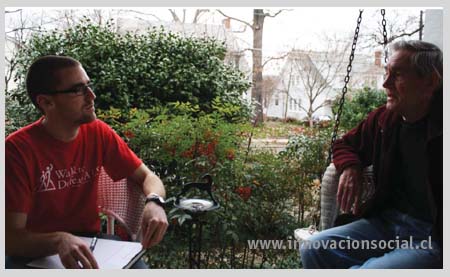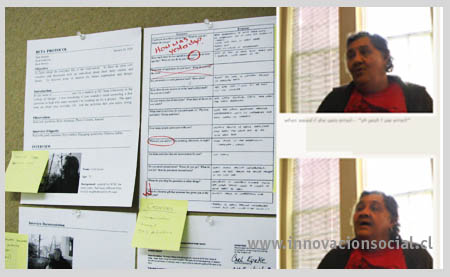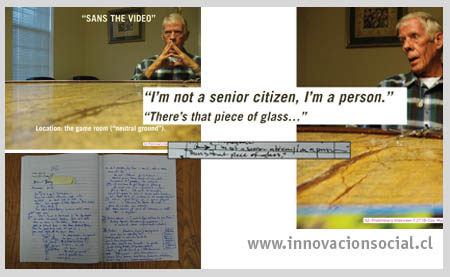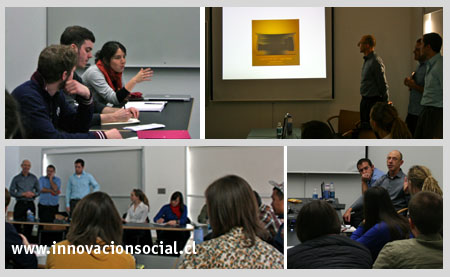Posts filed under ‘US Version Design for Social Innovation’
Course: Design-in-Difference NC State College of Design
 Picture: Sid Ahmed being interviewed in Mauritania [CM].
Picture: Sid Ahmed being interviewed in Mauritania [CM].
Due to the increasing demand of students interested in working with communities and learning new methods, we have designed the course: Design-in-Difference LAR582.009. The 3 credit lecture will be given by Assistant Professor of Landscape Architecture Kofi Boone [Ghana Study Abroad Program] and PhD Design-Anthropology Student Constanza Miranda [Design for Social Innovation Studios in Chile and the States]. The course will work with a partnership with the OIS to develop a 1 minute documentary piece that will summarize the engagement process with an (more…)
Methods/ Opportunity Detection/ Field Research 2
Post in English y Español

ENG/ FEB 8/ DESIGN FOR SOCIAL INNOVATION STUDIO/ Raising opportunities in the field [focused field research] After deploying behaviors and emotional drivers, through the “affinity diagrams“, we have a notion of certain things we would like to look at. The students go back to the field, but to do a more focused research. Students are looking for areas where they may find opportunities for design. Visualization plays an important role in displaying and analyzing the information. For visualization check on: Sless, Tufte, Good (more…)
(more…)
Method/ User Behaviors & Mental Models
FEB1/ Mapping visually to understand behaviors/ What moves people? After going to the field we define some aspects, behaviors and activities that are relevant. The teams do a brainstorm session to put down and associate some of these ideas. We use to “anchor” words: DRIVERS (emotional + functional) and TRANSGENERATIONAL DESIGN. After commenting everyone’s appreciation and thoughts over these two topics, the designers organize the information in affinity diagrams. By mapping their ideas out, they find a particular scope to narrow down the following field explorations. 

Approaching the end-user/ Field research 1
JAN 29/ Towards opportunity detection-areas for intervention After testing the protocols, the teams go doing field research using them. A basic applied research toolbox will help us to design and imagine new research methods or ways to raise information. We aim to have a participative spirit in them; yet, now we are in an exploratory phase, so the applications are open-ended. In applying the tools for interviewing and observing, the teams should accomplish objectives defined by them. Interviews were done in an exploratory fashion. Warm up questions were identified as critical to gain the trust of the interviewees. For the moment, the relationship with the people is being built, so some of the teams were allowed to go in the people’s houses. Some could be toured, discovering and registering gadgets and personal stories that had to do with them. Some realized that they needed to produce better protocols or adjust the ones they had to the needs and ideas that aroused in meeting the participants. Matters like discrimination, technology, communication, physical boundaries, emotional aspects, being part of the community appeared to be relevant to the people at Parkview Manor.
Check on the students’ blogs!
2010-Design for Social Innovation interdisciplinary studio/ Student’s will maintain a blog so you can follow up their particular processes and pictures. Check on the links on the side of the blog. [example:Sam Cox & Rebecca Myer’s]
[example:Sam Cox & Rebecca Myer’s]
1.3 Approaching the end user: BETA protocols
1.3 JAN25/ Beta approach to end user and protocol design We want to design with the people not just for the people, so we need to know their expectatins, goals, needs and ideas. It is absolutely important to go to the field with a plan. Not a static plan, but an organic one that might adapt to the researcher’s needs. It is not enough just to acknowledge the tools to work with, but to know whom we are working with, in what conditions and what we want to get from this experience. So a “roadmap” should be made before making any moves. This is a research protocol. Also it is a good thing to test it. This, in allusion to Google’s concept, I’ve called it a Beta Protocol. By testing it in real contexts, it is easier to make changes before getting to the real situation. We use and modify Eric Dishman’s [http://www.intel.com/pressroom/kits/bios/edishman.htm] the Ask, Perform, and Observe protocol. Yet, with some typical recommendations in anthropological research [Schensul, Jean J., and Margaret Diane LeCompte, 1999 Designing and Conducting Ethnographic Research. Vol. 1. Thousand Oaks, Calif.: AltaMira Press]. A basic research toolbox will help us to design and imagine new research methods or ways to elicit and collect information. They can be participative, and they should look to be designed accomplishing the objectives defined by the student.
The students made 1 to 1 in-context interviews to elder people from around Raleigh. Interviews are particularly useful for this EXPLORATORY PHASE. Researchers designed charts and other graphic supporting material to collect the information in an organized and thoughtful fashion. This material is the one subjected to change. We won’t just modify the protocol itself, but also the worksheets used for the researcher’s data collection. There is also designed material to write reflective insights post-interview. This is used when team meets to check out the audiovisual material. Students did modify the typeface for the informed consent forms to enhance the readability of the participants. They also changed some approaches to questions and ways to download the information. The team profits from the information interchange that takes place within the class. Rebecca Myers and Sam Cox did revise once and again their protocols, going into the field and revising the processes and the material after.  They were very successful with their insights.
They were very successful with their insights.
1.1 Quantitative and qualitative secondary data on the topic
 JAN22/ FIRST @DESK SONDEO In an exploratory phase, it is relevant to a first approach to the topics we will be working on. That being: aging, transgenerational design, user-centered methods, design research, etc. We, always come into research with our values, our assumptions and our beliefs. To start thinking on others, we have to build upon the existing knowledge, the ideas that have been written about a certain theme and the research that has been done. We need to be ‘pre-informed’ about what others have been investigating on the area or even just collect secondary data not to immerse in a “blind exploration”.
JAN22/ FIRST @DESK SONDEO In an exploratory phase, it is relevant to a first approach to the topics we will be working on. That being: aging, transgenerational design, user-centered methods, design research, etc. We, always come into research with our values, our assumptions and our beliefs. To start thinking on others, we have to build upon the existing knowledge, the ideas that have been written about a certain theme and the research that has been done. We need to be ‘pre-informed’ about what others have been investigating on the area or even just collect secondary data not to immerse in a “blind exploration”.  This is a choice, as we believe is important to have some kind of idea when you have interchange with stakeholders. They frequently manage information (either coming from market research or other source). This would be something similar to the “Sondeo” but an “@-desk-sondeo”.
This is a choice, as we believe is important to have some kind of idea when you have interchange with stakeholders. They frequently manage information (either coming from market research or other source). This would be something similar to the “Sondeo” but an “@-desk-sondeo”.

A Sondeo means to get a sense of what is happening. We’ve adapted it to be a pre-phase to inform the exploratory research phase. The information is mapped in an associative way, so that the students can identify areas of interest. William Calloway and Celise Bravo-Taylor made an excellent graphic map for the quali/quanti sondeo. Through hierarchization of topics and data they achieve some sense of what is going on under their own informed criteria.  The other groups also did a great job in understanding main ideas like: considering other key actors such as care givers, taking in account that old people weren’t always old, which are their isolation state, etc. We looked around interesting topics to “put their hands on” in the exploration to begin.
The other groups also did a great job in understanding main ideas like: considering other key actors such as care givers, taking in account that old people weren’t always old, which are their isolation state, etc. We looked around interesting topics to “put their hands on” in the exploration to begin.
Feedback from Design Central Team
Team,
It was great to meet everyone involved with the class and especially great to start getting our heads wrapped around this opportunity in social innovation. What’s so incredible to think about is that in this program, you hold the potential to invigorate the world with fresh thinking, sustainable ground-breakers, and market shifting ideas that could be noticed world-wide!!!! Bringing your creative energy and clear perspective could make the difference from what has been done in the past to a new level of excitement that not only solves needs better than ever, does it in an amazingly engaging way, and at reasonably low cost. We are excited to see the problem identification and ideas that individuals from various backgrounds will come to find. This is an awesome opportunity to work with people who are able to bring an understanding and perspective to the table that we might overlook in our own little bubble. In addition, it will be especially interesting to see problems begin to emerge that our prior stereotypes or notions may have discounted. Having the liberty to go out and meet people who open their lives up to us will prove to be very telling if we keep our eyes open! We left North Carolina inspired by the program NCSU has built. Both students and faculty seem to have established a wonderful cross-disciplinary atmosphere that can be a breeding ground for forward thinking and truly innovative ideas. Build upon this energy and take advantage of the resources before you. This is a quote by Jamie Lerner, “Creativity starts when you cut a zero from your budget”. We look forward to seeing everyone’s creative solutions that work within the given parameters and push conventional thinking!
-. Gregg Davis/ Rick Hagee/ Richard Lane.-
1.2 Meeting with counterpart + Lecture
Jan 13th/ Limitations and requirements of the project. Meeting real counterparts become indispensable to understand the limitations and boundaries of the project. Overall when we are engaging in a “business reality”. In this case, we have various stakeholders, one of them is the community itself (social project). Yet, to make the project more “real” to our designers, we will be partnering (joint venture) with Design Central Studio, from Ohio: http://www.design-central.com . They’ll be participating and collaborating with the course as counterpart and stakeholders. Contact will be kept throughout the semester via Skype. Gregg Davis, Richard Lane and Rick Hagee, from Design Central, will be assisting the course. In this first contact, some ideas and boundaries were set upfront to the our Studio. We also had the participation of anthropologist Alexa Anderson.  Ideas like: How should we, as designers, develop engaging experiences were posed. “We should get into their heads”, Davis mentioned. They remarked the idea that old people shouldn’t lose their identities, we can’t treat them all as a whole. They have independent ideas, expectations and emotional motivations. What are their psychological needs? The DC group mentioned that there might be stereotypes in our minds that should be vanished. Social isolation is definitely a theme to consider. Some actual solutions were also criticized, as they are made essentially from just the designer’s point of view, without considering the people involved. Other topic that was relevant was not just to work on Functionality, but also with emotionality (see diagram).
Ideas like: How should we, as designers, develop engaging experiences were posed. “We should get into their heads”, Davis mentioned. They remarked the idea that old people shouldn’t lose their identities, we can’t treat them all as a whole. They have independent ideas, expectations and emotional motivations. What are their psychological needs? The DC group mentioned that there might be stereotypes in our minds that should be vanished. Social isolation is definitely a theme to consider. Some actual solutions were also criticized, as they are made essentially from just the designer’s point of view, without considering the people involved. Other topic that was relevant was not just to work on Functionality, but also with emotionality (see diagram).

Finally, Gregg Davis gave an open lecture to the Design community at NC State. He touched the basic topics of Design and emotions, showing us some findings and insights coming from researchers in Yale and Princeton through MRI investigations of Brain reactions to decisions. Based on the relationship we have with products/brands and making a comparison with the relationships we have with people. He calls this the 5 emotional stages: 1) impressions 2) interactions 3) reliance 4) extended trust 5)a dvocating. These relationships can help us to set up steps for the goals that we want to achieve with our end-users. We would like them to “bond” with our designs, overall to achieve sustainability and not to make products that are fashionable but disposable. We should consider these things in our research.
Open Lecture (linked with our Studio)
We invite the design community to the lecture of the studio that will be partnering in joing venture with us: DESIGN CENTRAL. We are happy to work with them and engaging in Social Innovation themes!
 Gregg Davis / 4 Emotional Stages
Gregg Davis / 4 Emotional Stages
Wednesday, January 13th / 18:30 Burns Auditorium
NC State, College of Design









